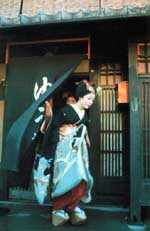by Chalerm Raksanti
Carefully crafted gardens, golden pavilions, and
historic monuments still give testament to the golden age of court life in
Japan’s ancient cities of Kyoto and Nara. Just 40 miles apart, these
towns together are considered the cultural center of Japan. It was here
that Japanese art and aesthetics developed and Nara still holds the title
of the nation’s spiritual heart.
 One
of Nara’s many masterpieces of early architecture, this temple is
dedicated to Buddhist healing.
One
of Nara’s many masterpieces of early architecture, this temple is
dedicated to Buddhist healing.
During the 5th and 6th century Chinese cultural
influence in Japan was particularly strong and a new city was laid out in
a grid model imitating the then Chinese capital of Changan (modern Xian).
This new city, Nara, became a cosmopolitan center. Visitors from all over
Asia arrived with exotic wares to sell and fresh ideas to share.
 Kinkakuji
(Golden Pavilion) was built by the third Ashikago shogun (1358-1408) as a
retirement villa. He requested that it be turned into a temple after his
death.
Kinkakuji
(Golden Pavilion) was built by the third Ashikago shogun (1358-1408) as a
retirement villa. He requested that it be turned into a temple after his
death.
The period in which Nara was an important capital saw
the birth of Japanese literature and poetry. Traveling Buddhist monks
returned to Japan with new texts and doctrines from China and India. State
support of Buddhism led to the building of the sprawling Todjaiji. This
rambling temple complex is the largest wooden building in the world. It
houses a giant bronze Buddha 53 feet tall. Dedicated in the year 752,
Buddhist clergy came as far away as India to witness the ceremony.
Another surviving structure which was originally a part
of the Todjaiji temple complex is Shosoin, a warehouse that contains more
than 10,000 treasured objects dating from the 8th century. These cherished
items were brought from all over the then “known civilized world”.
 The
proud tradition of the Japanese geisha starts with apprenticeship in the
Gion district of Kyoto.
The
proud tradition of the Japanese geisha starts with apprenticeship in the
Gion district of Kyoto.
The grounds of Kofukuiji, one of the Seven Great
Temples of Nara contain a magnificent 5 story pagoda built in the 730.
Five times it was destroyed by fire, but each time the people of Nara
rebuilt it to its original specifications. These are Japan’s national
treasures and they still stand today, clustered around Nara Park at the
city center. Huge oaks, cedars and wisteria grace the 1,300 acre stretch
of rambling greens known as Deer Park. More than a thousand tame deer are
free to roam the commons.
The streets, architecture gardens and museums of both
Kyoto and Nara are steeped in history and the romantic glory of these
ancient capitals is alluring. A visitor to these cities is taken back in
time to a world when grace and elegance embodied a way of life that is
impossible to recapture.
 School
children pet the tame deer of Nara’s Deer Park. 1,300 acres of greenery
allow more than a thousand deer are free to roam through this oasis in the
city’s center.
School
children pet the tame deer of Nara’s Deer Park. 1,300 acres of greenery
allow more than a thousand deer are free to roam through this oasis in the
city’s center.
It is fortunate indeed that these two cities were
spared bombing during World War II. For almost nowhere else does Japan’s
opulent and varied past stand out so vividly. This is truly the cradle of
the nation’s civilization.
As the seat of the emperor and his court from more than
a thousand years, Kyoto was and continues to be the seat of Japanese
culture and aesthetic traditions. Although now a modern city, its
historical monuments and treasures are in evidence everywhere and it is
here that almost 20 percent of Japan’s designated National Treasures and
15 percent of the nation’s important “cultural assets” are located.
Over 200 Shinto shrines and approximately 1,600
Buddhist temples are located throughout the city. Some of these, like the
gleaming Kinkakuji (Golden Pavilion) have been destroyed by fire, but were
rebuilt precisely to their original splendor using traditional methods of
construction.
Gardens are another cultural display of Japanese
artistic tradition and spiritual philosophy. More than 60 of the
nation’s most spectacular gardens are in Kyoto, including the elegant
moss garden of Shaihoji and the mysterious and enigmatic stone gardens of
Ryoanji.
Kyoto celebrates its cultural birthright with many
annual festivals. One of the most spectacular is the Gion Festival. This
colorful display of ancient heritage is a procession of floats. The Jidai
Festival features a parade of men, women and children wearing costumes in
styles that date back more than a thousand years.
Not just a city of monuments Kyoto is the center of
traditional crafts. Lovely silk brocades and other fine fabrics are woven,
dyed and embroidered here. Tucked away throughout the city, tiny workshops
turn out delicate ceramics, lacquer ware and exquisite folding fans.
Japan’s most treasured and elegant geishas are also
apprenticed in Kyoto. Maikos are apprentices which are trained in the Gion
district, which are the geisha quarters of the city. Great knowledge of
Japanese classical dance and music is mandatory for geisha. They are
members of a respected and enduring tradition of which Japan is truly
proud.

 One
of Nara’s many masterpieces of early architecture, this temple is
dedicated to Buddhist healing.
One
of Nara’s many masterpieces of early architecture, this temple is
dedicated to Buddhist healing. Kinkakuji
(Golden Pavilion) was built by the third Ashikago shogun (1358-1408) as a
retirement villa. He requested that it be turned into a temple after his
death.
Kinkakuji
(Golden Pavilion) was built by the third Ashikago shogun (1358-1408) as a
retirement villa. He requested that it be turned into a temple after his
death. The
proud tradition of the Japanese geisha starts with apprenticeship in the
Gion district of Kyoto.
The
proud tradition of the Japanese geisha starts with apprenticeship in the
Gion district of Kyoto. School
children pet the tame deer of Nara’s Deer Park. 1,300 acres of greenery
allow more than a thousand deer are free to roam through this oasis in the
city’s center.
School
children pet the tame deer of Nara’s Deer Park. 1,300 acres of greenery
allow more than a thousand deer are free to roam through this oasis in the
city’s center.
